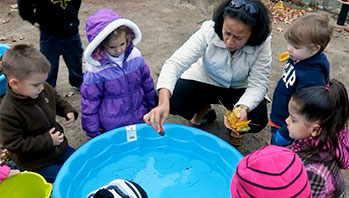- camera
- clipboards
- digging tools or sticks
- garden hose
- markers
- paper
- water containers (plastic buckets, bottles, and cups)
- yarn
- downhill
- flow
- pour
- puddle
MA Standards:
Language/L.PK.MA.6: Use words and phrases acquired through conversations, listening to books read aloud, activities, and play.
MA Draft STE Standards:
Earth and Space Sciences/Earth’s Systems/ESS2.A: Observe, investigate, and classify the non-living materials, natural and human made, in their environment.
Head Start Outcomes:
Logic and Reasoning/Reasoning and Problem Solving: Classifies, compares, and contrasts objects, events, and experiences.
Science Knowledge/Conceptual Knowledge of Natural and Physical Worlds: Observes, describes, and discusses properties of materials and transformation of substances.
PreK Learning Guidelines:
English Language Arts/Language 2: Participate actively in discussions, listen to the ideas of others, and ask and answer relevant questions.
Science and Technology/Earth and Space Sciences 5: Compare and contrast natural materials such as water, rocks, soil, and living organisms using descriptive language.
Science and Technology/Physical Sciences 19: Explore, describe, and compare the properties of liquids and solids found in children's daily environment.
Explore Together (outdoors): Changing Water Flow

© Commonwealth of Massachusetts, Department of Early Education and Care. All rights reserved.
STEM Key Concepts: Water flows downhill; You can change the direction water flows; You can use different objects to move water
ELA Focus Skills: Listening and Speaking, Vocabulary
Educator Prep: Before the activity, go outside to search for a sloping area where children can explore.
Safety Tips:
- Remind children to wash their hands before and after the activity.
- Be aware of and check for poison ivy, poison sumac, thorny or prickly bushes before gathering children in a designated area.
- Tell children they are going to explore how to change the direction of water flow. Review the materials and any rules and guidelines before taking them outside. Take children out to the pre-determined area.
Before children explore, ask them to describe the area. Acknowledge their descriptions, emphasizing that it is a slope, or a hill. Ask children to predict how they think the water will flow from the top of the hill. Encourage children to carefully watch the water as it flows to observe how the water changes directions as they are exploring and how the water slows down or speeds up.
Allow children to explore freely. Observe, listen to, and engage children if they show a particular interest in something or if you think you can facilitate their exploration. Ask questions such as,
- What do you think will happen if you pour the water at the bottom of the hill instead of the top? (will not flow/will make a puddle) Why do you think so?
- When do you notice the water speeding up or slowing down?
- What happens when the water hits a rock or a stick while flowing downhill?
- If you start pouring the water again, do you think it will follow the same path? Why or why not?
Have children make a drawing to record an observation of water flow.
Reflect and Share
Once inside, revisit the list of responses children gave when you asked how they might change the flow of water. Have children share their observations. Encourage other children to ask questions. Include any photos you took of their explorations. Ask,
- What happened to the water as it flowed down the steeper part of the hill?
- What happened to the water flow when it hit the stick that was across the path?
- Why do you think the water would not flow uphill when you poured it at the bottom of the hill?
